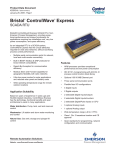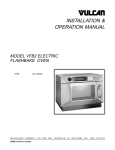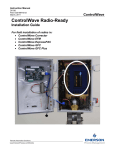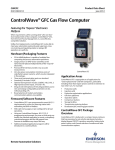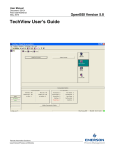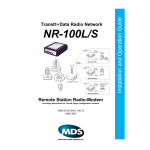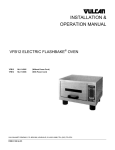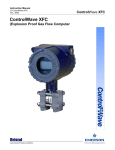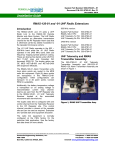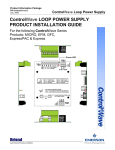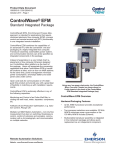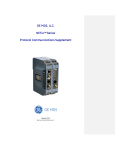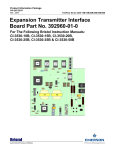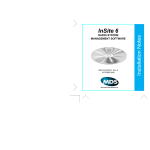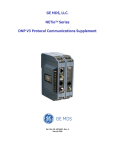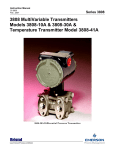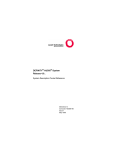Download Emerson Process Management Bristol ControlWave ExpressPAC User's Manual
Transcript
Product Data Document 420DS-7d / D301312X012 January 29, 2009 - Page 1 Bristol® ControlWave® ExpressPAC SCADA RTU Package Bristol® ControlWave® ExpressPAC, from Emerson Process Management, is a highly integrated preengineered package solution that combines the new ControlWave Express SCADA RTU with a variety of options commonly required in SCADA applications. These include a compact Nema 4X rated enclosure, power supply and solar panel options with battery backup, operator display/keypad input options, and wireless communication options. Standardization eliminates the need for in-house panel and packaging design and fabrication resulting in lower initial installation cost. This also standardizes the maintenance effort to reduce the long term cost of ownership. As an integrated RTU in a SCADA system, ControlWave ExpressPAC has the unique attributes required for wide area networks, without sacrificing process control performance. Application Suitability Based on years of experience in water, gas and SCADA related industries, ControlWave Express has the technology, functional benefits and open architecture to excel in many applications. Water distribution: Pump, tank, well and reservoir control • Pre-engineered SCADA RTU package solution reduces integration and maintenance costs • Multiple serial communication ports for network, local and multi-vendor connectivity • Built-in BSAP, Modbus & DNP protocols for broad network compatibility • Report-By-Exception for communication efficiency Features • Modbus Store and Forward capability for geographic flexibility with radio networks • ARM processor provides exceptional performance and low power consumption • Ultra low power modes minimizes cost of solar/ battery power systems • IEC 61131-3 programming with ACCOL III process control function block library • Wide operating temperature range for remote outdoor locations • Optional 100/10 MB Ethernet port • Three serial communication ports • Flexible fixed I/OI configurations • 4 Digital inputs • 2 Digital outputs Remote Automation Solutions Website: www.EmersonProcess.com/Remote Wastewater: Lift station and storm water monitoring Natural Gas: Gas well, storage and plunger lift control Product Data Document 420DS-7d / D301312X012 January 29, 2009 - Page 2 • 2 selectable Digital inputs/outputs • 2 selectable Digital inputs/counters • 2 selectable Digital/Pulse inputs on CPU • 3 optional Analog inputs • 1 optional Analog output Bristol® ControlWave ExpressPAC ControlWave ExpressPAC Integrated Solution ControlWave ExpressPAC is delivered in a compact, Lexan enclosure that includes the RTU electronics, optional operator display/keypad, battery/solar power system and a broad selection of modem and radio communications options. Features – Package tuning parameters, and outputs used in a measurement or control application. Status bits include the alarm state, alarm acknowledge, control, and manual (Auto/Man). Providing access to such variable information allows the user complete control over the process operation. The standard LCD provides 4 line x 20 character display with either a two-button read-only or 25-button read-write keypad. Both display/keypad assemblies have the same “footprint” on the front door. Features – Display/Keypads • 4 line by 20 character backlit liquid crystal display • Adjustable display contrast • Membrane keys with tactile feedback • Self-adhesive overlay mounts to the enclosure door or panel (ControlWave ExpressPAC is delivered with this assembly installed on the door) • Dimensions, Lexan Housing: 15.77” H x 7.8” W x 9” D (40.1cm X 19.8cm X 22.9cm) • Nema Rating: Nema 3R (Nema 4x except with a battery vent) • Easy configuration via ACCOL III Function Block • Mounting: Pipe-mounted, or wall-mounted • Scrolling display mode • Solar Panel Mounting: All solar panels are delivered with all hardware necessary for 2” pipe or mast-mounting Integrated LCD Display/Keypad Option ControlWave ExpressPAC offers a convenient local operator interface. The 2-button display allows an operator to view site, configuration and process data. The screens are organized in a series of lists. The operator can select a list and then manually scroll through the data. Additionally, a “scroll list” can be defined. The ControlWave ExpressPAC can be set to automatically sequence through this list. The 25-button Display/Keypad performs the same functions and additionally allows the operator to view and modify ControlWave ExpressPAC inputs, process variables, calculated variables, setpoints, Remote Automation Solutions Website: www.EmersonProcess.com/Remote Shown, above, is the LCD with 25-button keypad. The 2-button version is similar but includes only two “arrow” buttons to sequence through lists. Product Data Document 420DS-7d / D301312X012 January 29, 2009 - Page 3 • Adjustable timer turns off display when not in use Specifications – Display/Keypads • Window size: 1.1” H x 3.1”W (2.8cm x 7.9cm) • Character size: 4mm H x 3mm W • Dimensions: 7.4”H x 5.5”W (18.8cm x 14.4cm) • Power consumption: 2.5 mA @ 3.3V (0.008 watts) • Operating Temperature: -4 to 158ºF (-20 to 70ºC) Scalability ControlWave ExpressPAC can also be combined seamlessly with other members in the ControlWave family of products. For remote applications requiring more I/O flexibility, ControlWave Micro provides a modular RTU/PLC expandable up to 14 I/O modules. For natural gas well site and measurement station automation, ControlWave single and multi-run flow computers share a common architecture with the ControlWave family of products and all meet API 21.1 requirements for multiple meter runs. For in-plant control applications, ControlWave and ControlWave Micro are powerful, flexible PLCs. ControlWave offers the greatest local and remote I/O expansion to hundreds of I/O points, up to three Ethernet ports for network segmentation, plus CPU, communication and I/O redundancy capability. The combined benefits of the ControlWave family of products integrates your wide area network with your local area network. Open Standards For Programming, Network Configuration and Communication Only ControlWave brings the perfect combination of industry standards to minimize learning, engineering and implementation costs. Remote Automation Solutions Website: www.EmersonProcess.com/Remote Bristol® ControlWave ExpressPAC By adhering to such industry standards as Ethernet, TCP/IP, Microsoft Windows®, COM/DCOM, FTP, OLE and ActiveX, ControlWave is able to achieve the highest degree of openness in control system architecture and bring the optimal process efficiency and productivity needed to ensure a successful system implementation. ControlWave Designer with ACCOL III To minimize your engineering and development time, we have adopted the international standard for PLC programming, IEC 61131-3. ControlWave Designer is a fully IEC 61131-3 compliant programming environment for the ControlWave family of products. ControlWave Designer includes all five IEC 61131-3 process languages for batch, continuous and discrete control: Function Block Diagram, Structured Text, Sequential Function Chart, Ladder Logic Diagram and Instruction List. ControlWave Designer includes an extensive library of more than 200 basic IEC 61131-3 functions and function blocks common to many IEC 61131-3 based products. These include: • Flip-flops, Counters & Timers • Ladder diagram functions – coils and contacts, etc. • Numerical, Arithmetic & Boolean functions – Sine, Cosine, Add, Sub, Square Root, And, Or, etc. • Selection & Comparison – Min, Max, Greater than, Equal, Less than, etc. • Type conversions – Integer to Real, Boolean to Word, etc. ACCOL III In addition to the basic functions and function blocks, ControlWave Designer brings the benefit of over twenty years of SCADA and plant control experience in Emerson’s Bristol ACCOL III function block library. ACCOL III includes over sixty function blocks valuable for use in oil & gas, water & waste and process measurement & control applications. Further, Product Data Document 420DS-7d / D301312X012 January 29, 2009 - Page 4 Bristol® ControlWave ExpressPAC ACCOL III is designed to take full advantage of the significant features offered by ControlWave. • Briefly, this library includes function blocks for: Power Input • Average, Compare, Totalize • • Scheduling & Sequencing 5.4 to 16 Vdc power input with 14 MHz CPU - Surge suppression 16 V transorb • PID & Lead/Lag • • AGA gas flow and liquids calculations 9.0 to 30.0 Vdc power input with 33 MHz CPU - Surge suppression 30 V transorb • File handling • Power-fail detection and recovery sequencer • Battery voltage monitor • Reverse voltage protection In addition, ControlWave ensures data integrity, in the event of a communication interruption, by storing critical time-stamped alarm and historical data in the controller memory. This data is then securely retrieved when communication is restored. One RJ45 connector for interface to ControlWave LCD Display/Keypad Environmental Specifications • Operating Temperature range: 40 to 70ºC (-40 to 158ºF), 85ºC storage Specifications -20 to 70ºC (-4 to 158ºF) with display/ keypad -20 to 60ºC (-4 to 140ºF) with Lead Acid Cell Batteries CPU • 32-bit ARM processor: 14 & 33 MHz CPUs • Sleep mode for low power applications • Real time clock/memory battery backup: 9000 hours • Program execution and Data Memory : 2 MB battery backed SRAM memory • Data and file storage memory: 8 MB Flash for Program source, historical Archive and Audit storage • Historical Archive memory: Stored in flash • Immunity: ENV 50140 Radio-frequency • Optional solar power regulator • Electromagnetic field amplitude modulated EMC • LED status indicators – Watchdog and CPU Idle LEDs • Emissions: EN 55022:1998 Class A ITE emissions requirements (EU) • ICES-003 Issue 3 Class A Digital Apparatus emissions requirements (Canada) • AS/NZS3548:1995/CISPR Class A ITE emissions requirements (Australia) Communication • Two RS-232 and one selectable RS-232/RS485 serial communication port supporting baud rates up to 115.2 KB • One optional 100/10 Base-T Ethernet port with RJ45 connector Remote Automation Solutions Website: www.EmersonProcess.com/Remote • Relative Humidity: 15-95% non-condensing • Vibration: 2.0g for 10-150 Hz – 1.0g for 150Hz to 2000Hz • RFI Susceptibility:3V/m – 80 MHz to 1000Mhz (EN50082-2) • Electrostatic Discharge: Meets IEC EN 60001-4-2, EN 61326 CPU RFI Product Data Document 420DS-7d / D301312X012 January 29, 2009 - Page 5 I/O RFI Susceptibility: 3V/m – 80 MHz to 1000Mhz (IEC 1000-4-3) Hazardous Area Approvals • Approved as non-incendive for operation in Class I, Division 2 • Class I, Division 1 approval pending for a subset of configurations ControlWave ExpressPAC is approved by UL as an instrument. This certification does not allow installation of any other hardware, not indicated by the model number, in the instrument enclosure. Wiring to and from the I/O, communication and power connections inside the enclosure, per the ControlWave ExpressPAC manual, are, of course, allowed. Bristol® ControlWave ExpressPAC Features • Convenient pluggable local • All configuration jumpers and switches accessible without disassembly of circuit boards • Termination points for external loop power supply Specifications All I/O • I/O access: 50 ms with 33 MHz CPU, 250 ms with 14 MHz CPU • 1 second for 2 DI/PI inputs on CPU board • Surge protection: Meets C37.90-1978 30 Vdc transorb between signal and ground • Terminations are pluggable and accept a maximum wire size of 16 gauge • Power consumption is stated for each I/O module type measured at the input supply and does not include loop power Power Consumption 14 MHz CPU: 0.036 watt 33 MHz CPU w/o Ethernet: 0.12 watt 33 MHz CPU with Ethernet: 1.0 watt DIO card: 0.018 watt DIO plus AIO card: 0.021 watt Pulse/Digital Inputs • Inputs located on base CPU board ControlWave ExpressPAC Process I/O • ControlWave Express I/O module is designed to maximize usability while minimizing installation and maintenance. Number of points: up to 2 non-interrupting inputs • Internally sourced, dry contact single ended inputs • Scan rate: Once per second • Input filter: 20 microSec • Voltage Range: Internally sourced dry contact input - 3.3 Vdc The I/O module provides a mix of analog and digital inputs and outputs that are a perfect fit for small RTU applications. • 2 DI/PI (on CPU) • 1 RTD input on 14 MHz CPU • On state: >1.6 V, Off state <1.3V • 4 DI • Input current : 200 µA for low power applications • 2 DO • Power consumption: • 2 selectable DI or DO 200 µA input, all inputs ON: 0.002 watt • 2 selectable DI or HSC Used as Pulse Input: • Optional 3 AI or 3 AI and 1 AO Remote Automation Solutions Website: www.EmersonProcess.com/Remote • Frequency Range: 0-10 kHz Product Data Document 420DS-7d / D301312X012 January 29, 2009 - Page 6 Bristol® ControlWave ExpressPAC Debounce: None Digital Outputs Accumulator: 16 bit • Number of points: 2 dedicated, 2 selectable DO (2 DI/DO) RTD Input • Output type: solid state open drain MOSFET • • Operating voltage range: 10 - 31Vdc • Maximum operating frequency: 20 Hz • Current sink capability: 400 mA at 16 V (6 V system), 400 mA at 30 V (12/24 V system) • Power consumption: • Input available on 14 MHz Ultra Low Power CPU only Specifications are for the interface, only, not including the RTD probe or wiring • RTD Conversion Accuracy: ± 0.1°C, or ± 0.1% of reading, whichever is greater • Ambient temperature effect on RTD measurement: ±0.01°C / °C max • Long Term Stability at Constant Conditions: ±0.25ºC / month max Not applicable to DOs Analog Inputs • Number points: 3 AI optional Digital Inputs • AI Resolution: 14 bit • Number of points: up to 4 dedicated DI and 4 selectable DI (2 DI/DO, 2 DI/HSC) • • Non-interrupting inputs Input Configuration:Externally sourced. Single– ended inputs - jumper selectable 4–20 mA or 1–5 Vdc • Internally sourced, dry contact single ended inputs • Input Impedance: 1 megΩ - 1 5 Vdc; • 250 Ω - 4-20 mA • Input Voltage Range: Internally sourced dry contact input - 3.3 Vdc • Input Filtering: 12 Hz • Channel Settling Time: 600 ms to be within 0.01% of input signal • On state: >1.6 V, Off state <1.3V • Input current : • Input accuracy: 4 DI selectable 60 µA for low power applications or 2 mA for in-plant noise immunity • 0.1% of span at 25ºC • 0.2% of span -40 ºC to 70 ºC 2 DI/DO selectable 200 µA or 2.2 mA • Power consumption: 2 DI/HSC selectable 200 µA or 2.2 mA Not applicable • Input filtering: 15 ms time constant (contact bounce) Analog Output • Power consumption: • Number of Channels: 1 AO optional All 8 inputs ON: 0.005 watt • Output configurations: Selectable externally sourced 4-20 mA or 1-5 Vdc: (4 inputs @ 66 µA and 4 @ 200 µA) All 8 inputs ON: 0.075 watt (4 inputs @ 2 mA and 4 @ 2.2 mA) Remote Automation Solutions Website: www.EmersonProcess.com/Remote 250 ohm with 12 V external source 650 ohm with 24 V external source Product Data Document 420DS-7d / D301312X012 January 29, 2009 - Page 7 Bristol® ControlWave ExpressPAC 1-5 Vdc @ 5mA max., 11 to 30 Vdc external source batteries are matched with solar panels as charging sources. • D/A resolution: 12 bit • Accuracy: Related to the power system, a charge regulator circuit and, in the 12 Vdc versions only, an auxiliary output (AUX Output) is available in ControlWave ExpressPAC (except models with Ethernet). The AUX Output is typically used to control power to the radio. 0.1% of span @ 25ºC for current output; 0.1% + 3% of span @ 25ºC for voltage 0.3% of span @ -40 to 70 ºC for current 0.3% + 3% of span @ -40 to 70 ºC for voltage • Power consumption – 1 outputs: Specifications – Charge Regulator and AUX Output Analog current output: 0.1 watt • Input Voltage Range: 5.0 to 18.0 Vdc Analog voltage output: 0.1 watt • Fuses: 1.5 A from charge regulator, 3.5 A for each battery input, 1.0 A to the CPU assembly • Surge suppression: 18 V transorb. Meets ANSI/ IEEE C37.90-1978 • Charge regulator: Temperature-compensated charge control with cut-off • Standby charging circuit limits: 6.33V max, 6.09V min for 6V battery and 12.4V max, 11.9V min for a 12V battery • Threshold voltage for shunt at 23ºC: 7.3V for a 6V battery and 14.6V for a 12V battery High Speed Counters • Number of points: 2 selectable as HSC or DI • Frequency Range: 0-10 kHz • Input Voltage Range: Internally sourced: 3.3 Vdc Externally sourced: 3 Vdc to 24 Vdc • On state: >1.6 V, Off state <1.3V • Input filter: 20 microSec for 10 kHz HSC 1 ms for 300 Hz LSC • AUX Output Max Load Current: 1.8 A continuous, 2.5 A momentary • Input current : selectable 200 µA for low power applications or 2.2 mA for in-plant noise immunity • AUX Output “on” Resistance: 0.37 Ohms typical, 0.5 Ohms max • Accumulator: 16 bit Available Power Options • Power consumption: • 7.2 Vdc Lithium battery (single or dual) 200 µA input, all inputs ON: 0.004 watt • 6 Vdc, 1 watt solar panel, 7 AH lead acid battery 2.2 mA input, all inputs ON: 0.039 watt • 6 Vdc, 4.3 watt solar panel, 7 AH lead acid battery Power System, Charge Regulator and AUX Output • 12 Vdc, 4.5 watt solar panel, 7 AH lead acid battery ControlWave ExpressPAC offers a variety of internal power systems that includes lithium batteries and rechargeable, lead acid cell batteries. The lead acid Remote Automation Solutions Website: www.EmersonProcess.com/Remote Power systems are sized for operation with all I/O but without powering field devices. The 12 Vdc supply is sized to operate a radio in “slow duty cycle” mode. Product Data Document 420DS-7d / D301312X012 January 29, 2009 - Page 8 Bristol® ControlWave ExpressPAC Modem Specifications Radio Option The optional auto-dial / auto-answer modem provides a sleep mode that conserves power while allowing it to wake up when a call comes in. The ControlWave ExpressPAC is available with one optional FreeWave or MDS radio. • Function: Provides PSTN (Public Switched Telephone Network) communications • Operating Modes: Sync or Async. 2-wire switched network - Half or Full Duplex • Line Type: Two-wire loop start lines • Modem Configuration: “AT” based commands • Data Rate: V.32 bis - 9600 bps, V.32 - 9600 bps, V.22 bis - 2400 bps, V.22 - 1200 bps or 600 bps, V.21 - 300 bps, Bell 103J - 300 bps, Bell 212A - 1200 bps • Telephone Functions: Dialing and answering by AT commands. Automatic answering is also programmable • Approvals: Telephone - FCC Part 68 (also suitable for approval within Canada) • Trans. Output Levels: -10 dBm fixed (USA) - (015 dBm adjustable – firmware dependent) • PSTN Arrangements: Loop Start arrangement (transmission output does not exceed -10 dBm). Allows connection to any voice telephone jack Since some users prefer to procure the radios separately, Emerson offers “radio-ready” configurations for each of the standard radio models. Radio-ready models include literally everything except for the radio. The mounting bracket as well as all cables and connections are in place. The user or integrator/installer must simply mount the radio to the bracket and make connections. It is important to match the radio-ready configuration with the specific radio the user expects to install because cables and connections for the antenna, RS 232 port and power all vary by radio model. The optional Polyphaser surge protector is recommended with any radio selected. Power Consumption for the Radios NOTE: When conserving power, ControlWave Express turns power to the radios completely off instead of operating them in the sleep mode. Freewave FGR Spread Spectrum Radio Figures at 12 Vdc: • Isolation: Data Access Arrangement (DAA) with 1000 Vac (Modem to PSTN) • Receive: 75 mA • Sleep Mode Current: 0.5 mA (max) @ 12V (Input Voltage); 1.0 mA (Max) @ 6V (Input Voltage) • Transmit: 500 mA • Idle: 20 mA • Surge Capability: Withstand surge of 100A with 10 x 160 microsecond waveform • Temperature: Operating Range: -40º to +60ºC (-40º to 140ºF); Storage Range: -40º to +85ºC (-40º to 185ºF) • Relative Humidity: 15% to 90%, non-condensing Remote Automation Solutions Website: www.EmersonProcess.com/Remote MDS TransNet 900 Spreabd Spectrum Radio Figures at 13.8 Vdc: • Receive: 115 mA • Transmit: 510 mA MDS models 4710 and 9710 Licensed, UHF Radios with figures at 13.8 Vdc: • Receive: 125 mA • Transmit: 2000 mA Product Data Document 420DS-7d / D301312X012 January 29, 2009 - Page 9 MDS entraNet 900 IP Radio Figures at 13.8 Vdc: • Receive: 100 mA • Transmit: 510 mA MDS iNet 900 Ethernet/IP Radio Figures at 13.8 Vdc: • Receive: 203 mA • Transmit: 580 mA OpenBSI Simply Creative Emerson’s OpenBSI (Open Bristol System Interface) is a set of network setup, communication diagnostic, and data viewing utilities that provide access to both ControlWave and Network 3000 controllers and RTUs. OpenBSI is the only product available in the industry to bring such unique functionality and ease of use to the network level. At the core is the communication interface, written as a Windows communication server API through which other client applications communicate with the Bristol networks. OpenBSI supports both serial BSAP protocol and Ethernet Internet Protocol communication to ControlWave and Network 3000 RTUs and controllers. Bristol® ControlWave ExpressPAC • RS 232, Dial-line, cellular, radio, satellite, and Ethernet connections • Provides on-line download & signal variable changes • Allows network configuration through NetView • PC and Network communication diagnostics • OPC Server for interfacing to most HMI software • Harvester collects historical data on request or scheduled basis NetView is the basic configuration and application interface for all network operations. NetView uses a tree structure for network graphical display in the Windows Explorer style. Network nodes can be added on-line by simply dragging the node Icon into the tree. This invokes a configuration Wizard simplifying network setup. Through the NetView Wizard, the necessary network parameters are entered for node and IP address, alarm and message routing, and network communication media. Once configured, selecting any node allows direct access to the common OpenBSI utilities to reprogram, download a new application to the node, review communication statistics, view real-time data through DataViewer, and edit controller/RTU properties. OpenBSI Utilities Above this communication layer are a group of applications known as OpenBSI Utilities. These client utilities communicate through the server to collect and manage data gathered from the network, generate files based on collected historical data, collect alarms, and monitor and control OpenBSI communications. • Communication engine for PC applications • Supports ControlWave and Network 3000 serial and IP protocols Remote Automation Solutions Website: www.EmersonProcess.com/Remote Netview - Network configuration and application Launchpad Product Data Document 420DS-7d / D301312X012 January 29, 2009 - Page 10 Local Configuration Wizard allows local communication with any attached ControlWave controller or RTU to download system flashware upgrades, configure cold download parameters, and configure IP and soft-switch parameters. Bristol® ControlWave ExpressPAC WebBSI - WebBSI is a powerful and flexible software product bringing web technology to all of Emerson’s Bristol automation and SCADA products. WebBSI includes a set of ActiveX Controls for reading and writing real-time and historical data, trending, recipe editing and custom display generation. Through these controls, you can use the standard Microsoft Internet Explorer web browser to access Network 3000, TeleFlow and ControlWave products through a set of supplied HTML web pages. Configuration Wizard simplifies Network setup DataView is an on-line utility used to collect and display several types of process data, including signal values, data array values, signal lists, and audit trail information. Operators have the ability to alter signal values. Multiple DataView windows may be open simultaneously. Custom built web page interface using a standard web browser Real-time ActiveX Controls One of the many benefits OpenBSI brings to you is our use of open standards such as ActiveX Controls. ActiveX is another of the Microsoft standards, which allow plug and play with any ActiveX container, using Microsoft ActiveX container technology such as Visual Basic, HTML web pages, and Microsoft Excel The set of available ActiveX Controls provides the basic functions necessary to communicate and collect data from ControlWave. ActiveX Controls DataView for Real-time data display Remote Automation Solutions Website: www.EmersonProcess.com/Remote • Security – 56-bit encryption - allows the user to sign on to the RTU • Signal Value – displays signal values in various formats • Comm Statistics – works with a standard page that displays the RTU’s communication statistics Product Data Document 420DS-7d / D301312X012 January 29, 2009 - Page 11 • Configuration Info – works with a standard page that displays and allows the user to change RTU Configuration information • Historical – Collect and view historical archive and audit files The IP compliant ControlWave opens the door for owner controlled access via Web Pages. Any generic web page builder can be employed to create user defined pages to access ControlWave. The web pages are populated with these pre-configured ActiveX controls. Bristol® ControlWave ExpressPAC presented as a text file in the PC. This functionality is extremely useful in providing an event trail during communication or PC downtime or other system problem. • Archive Collection – collection and storage to disk of the ControlWave archive data • Audit Collection - collection and storage to disk of the ControlWave audit data. • Exports data files to third party, .CSV & ODBC applications • DDE compliant for use with other popular Windows applications Required Software • Microsoft Internet Explorer • Bristol ActiveX controls • OpenBSI LocalView or NetView Historical Data Collection High Historical Data Integrity The ControlWave Historical Data Collection system offers exceptional historical data integrity by providing time-stamped historical data storage in ControlWave flash memory. The historical data is collected, through OpenBSI on a scheduled or demand basis and converted to .CSV and ODBC compliant file formats for use in spreadsheets and reports. If data is missed due to a communication failure, it is collected when the communication is reestablished and the PC historical database is backfilled with the missing data. This distributed historical database architecture provides the greatest data reliability and integrity during communication or PC failure. Another important historical feature is the Audit storage and collection system. The Audit Trail is a file stored in ControlWave flash memory containing significant events and time-stamped alarms. The alarms stored in the Audit system provide a historical archive in addition to the real-time alarm reporting system. This file is also collected through OpenBSI and Remote Automation Solutions Website: www.EmersonProcess.com/Remote OPC Server With industry demand for open standards, ControlWave answers the call by embracing technologies that open the door for maximizing your efficiency and productivity. The OPC standard was developed by the OPC Foundation comprised of hardware and software suppliers from the process control community. OPC allows the engineer to select best in class hardware and software with confidence in their interoperability. Our OpenBSI OPC Server was among the first to comply with the OPC Foundation alarm and event server specification. • OPC Data Access 1.0a & 2.0 compatible • WindowsXP • Compatible with both ControlWave and Network 3000 systems • 32 bit multi-threading, multi-processor design • Automatic database builder • Integrated real-time data monitor • Supports OPC Browse interface • Supports both serial comm and IP Ethernet connections • Supports COM/DCOM & OLE Automation • Primary and Background polling scheme • OPC Alarm & Event Server support Product Data Document 420DS-7d / D301312X012 January 29, 2009 - Page 12 ControlWave Open Network Connectivity By embracing the open system network technologies available through TCP/IP, Ethernet, OPC, and Microsoft DNA, as well as pseudo standards such as Modbus and Open Modbus, ControlWave can provide a total Process Automation Management Solution for in-plant LAN based networks and Wide Area Network SCADA systems. With the exceptional connectivity provided by the ControlWave network, access to real-time data and operating conditions, historical data, maintenance and performance data are all available to the global network. ControlWave provides the needed information to the plant floor technician, operator, engineer, supervisor and corporate management, even external customers. Communication Protocols Like all of Emerson’s Bristol products, ControlWave supports BSAP (Bristol Standard Asynchronous Protocol), Modbus, DFI, CIP, DNP3, and serial ASCII as standard functions. These protocols are implemented in Flashware so no additional hardware is required to use any one or a combination of all protocols. Bristol® ControlWave ExpressPAC While BSAP is an open protocol, the added functionality of the messages provide much more capability than is found in other networks. • Global time-synchronization • Time-stamped Alarm reporting • Historical archive data transfer • Audit file transfer • On-line program editing • Diagnostics • Communication statistics Modbus Protocol Modbus - Modbus is often considered a de-facto standard protocol because of its broad usage as either the primary or a secondary offering in many measurement and control related products. Even with its common use, Modbus protocol actually has many variations. Consider Modbus RTU and Modbus ASCII, Master & Slave, Serial and TCP/IP Open Modbus. In addition there are considerations regarding supported function codes, floating point values and byte order. Bristol products support the following: • Modbus serial and TCP/IP Open Modbus (Ethernet) BSAP - All of Emerson’s Bristol Network 3000 and ControlWave RTU and controller products support BSAP protocol. BSAP is widely accepted as providing exceptional data integrity and greatly simplifies communication between controllers. BSAP is provided with interfaces for Master/Slave, vertical networks, and Client/Server, horizontal networks. In either case, variable lists are created in each controller that are easily passed from server to client or slave to master. • Master and Slave • Modbus RTU and ASCII • Modes 1 - 7, 8, 15 & 16 • IP modes 51, 52 & 53 • Integer and IEEE 4 byte floating point BSAP meets the definition of an industry-standard, open architecture protocol because if conforms to ISO standards 2629, 1745 and 2111, it is not proprietary in that Emerson does not charge a license fee and makes the protocol and documentation available to anyone. The Generic Serial Interface is a user programmable Master and Slave protocol used to send and receive messages typically with third party serial ASCII devices. This protocol can be used to interface with such devices and message boards, card readers and many measurement devices. BSAP Protocol Remote Automation Solutions Website: www.EmersonProcess.com/Remote Generic Serial Interface Product Data Document 420DS-7d / D301312X012 January 29, 2009 - Page 13 Bristol® ControlWave ExpressPAC Multi-user Security Access Security is an essential element of any open system, particularly those with Internet access. ControlWave employs a User Name/Password access system protected by a 56-bit encryption technique through the TCP connection. There can be up to thirty-two users, who sign-in using their name and password. Both the name and the password can be up to sixteen characters. The security system provides for up to sixty-four access rights to read and write data values and files via FTP, access and configure historical and audit data information, edit configuration, run internal diagnostics, read and reset system status. It further allows the programming software to read, write and download the ControlWave. The Secure Data Advantage ControlWave sets a new standard for providing intelligent control at the point where control is needed. Whether you need control on the plant floor or at a remote site in the “middle of nowhere” ControlWave is the solution for control, communication and secure data to help you make the right operating decisions. ControlWave was designed to provide the optimum level of data security using a distributed database architecture. All data including time & date stamped alarms, alarm limits, and historical data are stored locally in each industrially rugged ControlWave, thereby distributing your data integrity risk. To further ensure that the data is always current and historically accurate, the historical data is stored in non-volatile flash memory within ControlWave. Historical data is even maintained during and after program downloading. When historical data is collected from ControlWave, it is converted and appended to .CSV and/or ODBC compliant databases but does not destroy the original historical data stored in ControlWave, thus providing a flexible and secure historical data system that is clearly recognized as a benefit to virtually every industrial application. The Bridge Between Systems Continuing our tradition of introducing innovative new solutions while maintaining compatibility with existing systems, Emerson again provides a migration path for existing customers by bridging the new ControlWave system with Network 3000 systems already in place. The network bridge is enabled by employing the open architecture technologies afforded by TCP/IP and OPC in both networks. TCP/IP allows seamless Ethernet connectivity to both networks as well as the corporate Intranet so both ControlWave and Network 3000 controllers can reside and communicate on the same LAN. Emerson’s Bristol OpenBSI OPC Server facilitates the merging of the two networks for technical, engineering and operator data access. The data source, configuration and path are completely transparent to the OPC client. Real-time data can also be passed between the two communication networks making this a total Plant Automation Management Solution. © 2009 Remote Automation Solutions, division of Emerson Process Management. All rights reserved. Bristol, Inc., Bristol Canada, BBI SA de CV, the Flow Computer Division, and Emerson Process Management Ltd, Remote Automation Solutions division (UK) , are wholly owned subsidiaries of Emerson Electric Co. doing business as Remote Automation Solutions (“RAS”), a division of Emerson Process Management. FloBoss, ROCLINK, Bristol, Bristol Babcock, ControlWave, TeleFlow and Helicoid are trademarks of RAS. AMS, PlantWeb and the PlantWeb logo are marks of Emerson Electric Co. The Emerson logo is a trademark and service mark of the Emerson Electric Co. All other marks are property of their respective owners. The contents of this publication are presented for informational purposes only. While every effort has been made to ensure informational accuracy, they are not to be construed as warranties or guarantees, express or implied, regarding the products or services described herein or their use or applicability. RAS reserves the right to modify or improve the designs or specifications of such products at any time without notice. All sales are governed by RAS’ terms and conditions which are available upon request. RAS does not assume responsibility for the selection, use or maintenance of any product. Responsibility for proper selection, use and maintenance of any RAS product remains solely with the purchaser and end-user. Emerson Process Management Remote Automation Solutions Watertown, CT 06795 USA Mississauga, ON 06795 Canada Worcester WR3 8YB UK T 1 (860) 945-2200 T 1 (905) 362-0880 T 44 (1) 905-856950 Website: www.EmersonProcess.com/Remote Product Data Document 420DS-7d / D301312X012 January 29, 2009 - Page 14 Bristol® ControlWave ExpressPAC Model Specifications Model Number: CWEPAC - A - B - C D - E - F - G - H J - K - L M N DESCRIPTION A 10 B 20 CD CODE IntegralEnclosureandLCD/Keypad A 7½” x 11¾” Lexan with LCD display only, no Keypad 1 7½” x 11¾” Lexan, LCD, 2 Keys 2 7½” x 11¾” Lexan, LCD, 25 Keys 3 Power System B None - External Power Source is Necessary 1 7.2 V Lithium Battery, Single 2 7.2 V Lithium Battery, Dual 3 6 V, 7 AH Lead Acid Cell Battery and 6 V, 1 W Solar Panel System 4 6 V, 7 AH Lead Acid Cell Battery and 6 V, 4.3 W Solar Panel System 5 12 V, 7 AH Lead Acid Cell Battery and 12 V, 4.5 W Solar Panel System 6 Processor (CPU board has 2 PI/DI & 3 serial ports) CD Advanced CPU with gas calculations 30 Ultra low power CPU (5-18V, Solar reg, AUX Out & RTD interface, 14 MHz) A1 Low power CPU without Ethernet (9-28V, Solar regulator, Aux Out, 33 MHz) A2 CPU with Ethernet (9-28V, Ethernet, 33 MHz) A3 StandardCPUwithoutgascalculations E 40 Ultra low power CPU (5-18V, Solar reg, AUX Out & RTD interface, 14 MHz) S1 Low power CPU without Ethernet (9-28V, Solar regulator, Aux Out, 33 MHz) S2 CPU with Ethernet (9-28V, Ethernet, 33 MHz) S3 I/O Configuration E NoI/Omodule-BaseCPU2DI/PIOnly 0 2 PI/DI on Base CPU + 2 DI/DO, 4 DI, 2 DO, 2 HSC 1 2 PI/DI on Base CPU + 2 DI/DO, 4 DI, 2 DO, 2 HSC, 3 AI 2 2 PI/DI on Base CPU + 2 DI/DO, 4 DI, 2 DO, 2 HSC, 3 AI, 1 AO 3 Remote Automation Solutions Website: www.EmersonProcess.com/Remote Product Data Document 420DS-7d / D301312X012 January 29, 2009 - Page 15 Bristol® ControlWave ExpressPAC Model Specifications, continued Model Number: CWEPAC - A - B - C D - E - F - G - H J - K - L M N DESCRIPTION F 50 Mounting F Pole mount (pipe clamp and brackets) 1 Panel mount (with 4 fastening ears) GH 60 CODE Application Program None 2 GH 00 01 J Hazardous Area Certification J 70 None 0 Class I, Division 2 Non-incendive (UL/CUL - NI) 1 Remote Automation Solutions Website: www.EmersonProcess.com/Remote Product Data Document 420DS-7d / D301312X012 January 29, 2009 - Page 16 Bristol® ControlWave ExpressPAC Model Specifications, continued Model Number: CWEPAC - A - B - C D - E - F - G - H J - K - L M N DESCRIPTION K CODE Radio Cable/Mounting Hardware and Polyphaser Option XCWMPOLY No Radio 80 Without Polyphaser 0 Don’t forget to specify a “1” or “2” here 1 if a radio is selected in ‘LMN’ below! 2 With Polyphaser LMN 90 140 K Radio or Modem Option XCWMGRADIO LMN None 000 Dial-line Modem 001 Standard Freewave Radio All radios are located on the Radio 103 StandardFreewaveRadioReadyBracket in the ExpressPAC enclosure. 104 StandardMDSTransnetRadio 201 StandardTransnetRadioReady 202 Standard MDS 9810 Radio with Diag 301 Standard MDS 4710A Radio with Diag 310 Standard MDS 4710B Radio with Diag 311 Standard MDS 9710A Radio with Diag 320 Standard MDS 9710B Radio with Diag 321 Standard MDS 4710 A/B, 9710 A/B, 9810 Radio Ready 322 Standard MDS EntraNet 900 Radio (Serial Remote) 401 Standard MDS EntraNet 900 Radio (Ethernet Remote) 402 Standard MDS EntraNet 900 Radio (Access Point) 403 Standard MDS EntraNet Radio Ready 404 Standard MDS iNet 900 Radio (Remote Serial Gateway) 420 Standard MDS iNet 900 Radio (Remote Ethernet Bridge) 421 Standard MDS iNet 900 Radio (Access Point/Remote Dual Gateway) 422 Standard MDS iNet 900 Radio Ready 423 Remote Automation Solutions Website: www.EmersonProcess.com/Remote Product Data Document 420DS-7d / D301312X012 January 29, 2009 - Page 17 Remote Automation Solutions Website: www.EmersonProcess.com/Remote Bristol® ControlWave ExpressPAC

















